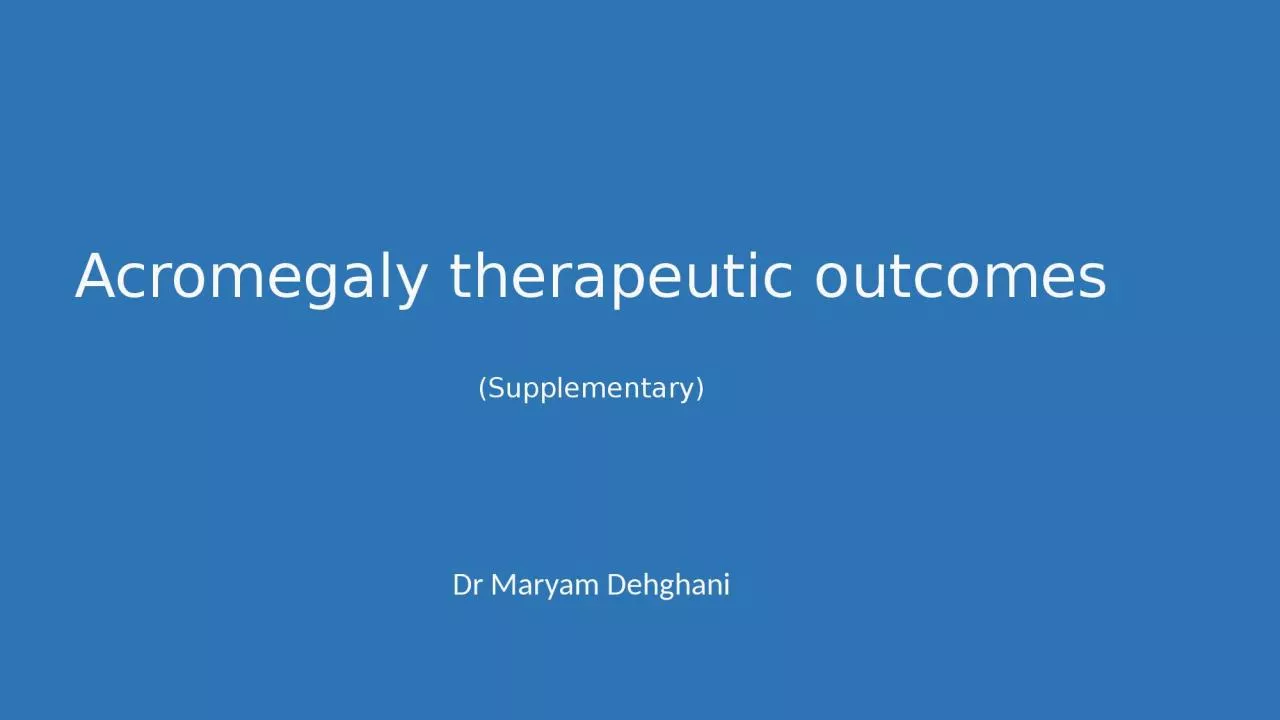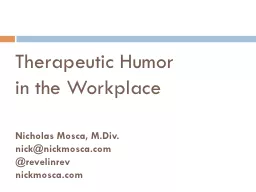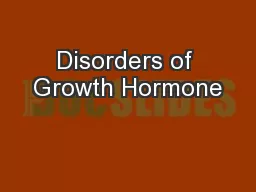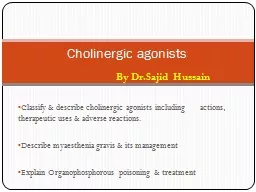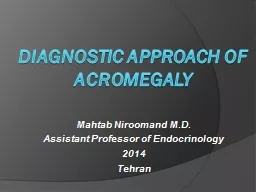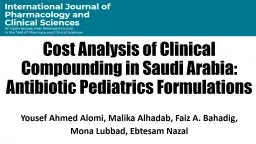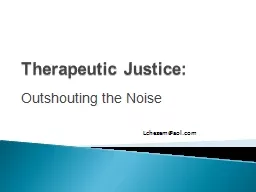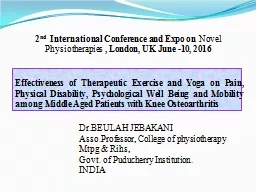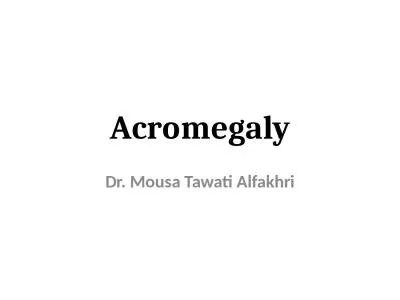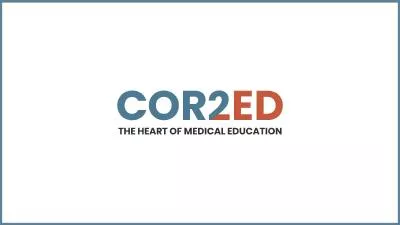PPT-Acromegaly therapeutic outcomes
Author : SchoolDaze | Published Date : 2022-08-04
Supplementary Dr Maryam Dehghani What is the value of somatostatin receptor scintigraphy to predict the effect of somatostatin analog therapy on pituitary
Presentation Embed Code
Download Presentation
Download Presentation The PPT/PDF document "Acromegaly therapeutic outcomes" is the property of its rightful owner. Permission is granted to download and print the materials on this website for personal, non-commercial use only, and to display it on your personal computer provided you do not modify the materials and that you retain all copyright notices contained in the materials. By downloading content from our website, you accept the terms of this agreement.
Acromegaly therapeutic outcomes: Transcript
Supplementary Dr Maryam Dehghani What is the value of somatostatin receptor scintigraphy to predict the effect of somatostatin analog therapy on pituitary adenomas 2014 2019 European Society of Endocrinology. John S. Burr, MD, FCCP. Illinois Heart and Lung Associates. Advocate Medical Group. <?xml version="1.0"?><AllQuestions />. <?xml version="1.0"?><AllAnswers />. <?xml version="1.0"?><Settings><answerBulletFormat>Numeric</answerBulletFormat><answerNowAutoInsert>No</answerNowAutoInsert><answerNowStyle>Explosion</answerNowStyle><answerNowText>Answer Now</answerNowText><chartColors>Use PowerPoint Color Scheme</chartColors><chartType>Vertical</chartType><correctAnswerIndicator>Checkmark</correctAnswerIndicator><countdownAutoInsert>No</countdownAutoInsert><countdownSeconds>10</countdownSeconds><countdownSound>TicToc.wav</countdownSound><countdownStyle>Box</countdownStyle><gridAutoInsert>No</gridAutoInsert><gridFillStyle>Answered</gridFillStyle><gridFillColor>255,255,0</gridFillColor><gridOpacity>100%</gridOpacity><gridTextStyle>Keypad #</gridTextStyle><inputSource>Response Devices</inputSource><multipleResponseDivisor># of Responses</multipleResponseDivisor><participantsLeaderBoard>5</participantsLeaderBoard><percentageDecimalPlaces>0</percentageDecimalPlaces><responseCounterAutoInsert>No</responseCounterAutoInsert><responseCounterStyle>Oval</responseCounterStyle><responseCounterDisplayValue># of Votes Received</responseCounterDisplayValue><insertObjectUsingColor>Blue</insertObjectUsingColor><showResults>Yes</showResults><teamColors>User Defined</teamColors><teamIdentificationType>None</teamIdentificationType><teamScoringType>Voting pads only</teamScoringType><teamScoringDecimalPlaces>1</teamScoringDecimalPlaces><teamIdentificationItem></teamIdentificationItem><teamsLeaderBoard>5</teamsLeaderBoard><teamName1></teamName1><teamName2></teamName2><teamName3></teamName3><teamName4></teamName4><teamName5></teamName5><teamName6></teamName6><teamName7></teamName7><teamName8></teamName8><teamName9></teamName9><teamName10></teamName10><showControlBar>Slides with Get Feedback Objects</showControlBar><defaultCorrectPointValue>100</defaultCorrectPointValue><defaultIncorrectPointValue>0</defaultIncorrectPointValue><chartColor1>187,224,227</chartColor1><chartColor2>51,51,153</chartColor2><chartColor3>0,153,153</chartColor3><chartColor4>153,204,0</chartColor4><chartColor5>128,128,128</chartColor5><chartColor6>0,0,0</chartColor6><chartColor7>0,102,204</chartColor7><chartColor8>204,204,255</chartColor8><chartColor9>255,0,0</chartColor9><chartColor10>255,255,0</chartColor10><teamColor1>187,224,227</teamColor1><teamColor2>51,51,153</teamColor2><teamColor3>0,153,153</teamColor3><teamColor4>153,204,0</teamColor4><teamColor5>128,128,128</teamColor5><teamColor6>0,0,0</teamColor6><teamColor7>0,102,204</teamColor7><teamColor8>204,204,255</teamColor8><teamColor9>255,0,0</teamColor9><teamColor10>255,255,0</teamColor10><displayAnswerImagesDuringVote>Yes</displayAnswerImagesDuringVote><displayAnswerImagesWithResponses>Yes</displayAnswerImagesWithResponses><displayAnswerTextDuringVote>Yes</displayAnswerTextDuringVote><displayAnswerTextWithResponses>Yes</displayAnswerTextWithResponses><questionSlideID></questionSlideID><controlBarState>Expanded</controlBarState><isGridColorKnownColor>True</isGridColorKnownColor><gridColorName>Yellow</gridColorName><AutoRec></AutoRec><AutoRecTimeIntrvl></AutoRecTimeIntrvl><chartVotesView>Percentage</chartVotesView><chartLabelsColor>0,0,0</chartLabelsColor><isChartLabelColorKnownColor>True</isChartLabelColorKnownColor><chartLabelColorName>Black</chartLabelColorName><chartXAxisLabelType>Answer Bullets</chartXAxisLabelType></Settings>. Dr Edward Hutchison FY1 (Geriatrics). Phase II Objectives. 3.21: . Investigations. . –. . Request appropriately the more common tests of thyroid, adrenal and pituitary gland function, seeking advice where necessary.. in the Workplace. Nicholas . Mosca, M.Div.. nick@nickmosca.com. @. revelinrev. nickmosca.com. . Who is this guy?. Theologian: . Inspirational . Speaker . & Writer. Educator. Neurotic . New Yorker . Practical Endocrinology. Wendy Blount, DVM. The Pituitary Gland. Two parts. Adenohypophysis – anterior lobe. Pars distalis. Pars intermedia. Pars infundibularis. Neurohypophysis - posterior lobe. Growth Hormone (GH) = Somatotropin. Describe . myaesthenia. gravis & its management. Explain . Organophosphorous. poisoning & treatment. C. holinergic agonists. By . Dr.Sajid. . Hussain. Cholinergic agonist- . Classification. Acromegaly. Very rare. Prevalence in the order of 1 in 200,000. Usually diagnosed between age 40 and 60. No difference in gender susceptibility. Insidious onset. Pathogenesis. Most commonly caused by pituitary adenoma. Mahtab. . Niroomand. . M. .D.. Assistant Professor of Endocrinology. 2014. Tehran. Out line. Introduction and epidemiology. Etiology and differential diagnosis. Clinical features. Survival . Diagnostic modality. Yousef Ahmed . Alomi. , . Faiz. Abdullah. . Bahadig. ABSTRACT: . Objective. : . To . analysis the anti-asthmatic medications therapeutic interchanges drug therapy. . Methods: . It is an extensive search, or fifty databases comprised the following through the Saudi Digital Library (SDL) searching engine. It encompassed the various types of studies (meta-analysis, randomized controlled studies and observational studies) in the English language with human study only for the update May 2017. The search in terms of therapeutic interchange, medication, therapy and type of disease or medication base on therapeutics class of Anti-psychiatric. The medication list and switch from one drug to another based on the literature found the search that has included comparative safety, efficacy and cost of the type of medication for each disease and national or international evidence-based guidelines. . Lchezem@aol.com. Entry to Criminal Court. A broad term that refers to judicial approaches that address the offender’s behavior as a problem requiring non-traditional sanctions and/or social services in addition to traditional sanctions.. 2. nd. International Conference and Expo on . Novel Physiotherapies. , London, UK June -. 10, . 2016. Dr.BEULAH. JEBAKANI. Asso.Professor. , College of physiotherapy. Mtpg. & . Rihs. ,. Govt. of . Past, Present and Future. Consultant Endocrinologist, . The Christie Hospital NHS FT. Honorary Senior Lecturer, . University of Manchester . SfE. BES 2022- Conflict Of Interest . Acromegaly is caused by . axcess growth . hormone (GH) secretion . due . to a GH secreting pituitary tumour (. somatotroph. . adenoma) usually . a . macroadenoma. .. GH excess . produces . gigantism in children (. Sheila Khawaja. 1. , Muriël Marks. 1. , Mark Gurnell. 2. , Maria Fleseriu. 3. . 1. World Alliance of Pituitary Organizations, Zeeland, Netherlands; . 2. Wellcome-MRC Institute of Metabolic Science, University of Cambridge & Addenbrooke’s Hospital, Cambridge, UK; . Prolactinoma. . (on medical treatment) was referred to endocrine clinic for high IGF1 level and impaired GH-GTT test. Presented by Suzan . Maleki. MD. 2023 JAN. Patient ID. 41 y/o man. From . Amol.
Download Document
Here is the link to download the presentation.
"Acromegaly therapeutic outcomes"The content belongs to its owner. You may download and print it for personal use, without modification, and keep all copyright notices. By downloading, you agree to these terms.
Related Documents

